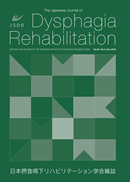Volume 18, Issue 3
The Japanese Journal of Dysphagia Rehabilitation
Displaying 1-11 of 11 articles from this issue
- |<
- <
- 1
- >
- >|
Original Paper
-
2014 Volume 18 Issue 3 Pages 221-228
Published: December 31, 2014
Released on J-STAGE: April 30, 2020
Download PDF (501K) -
2014 Volume 18 Issue 3 Pages 229-238
Published: December 31, 2014
Released on J-STAGE: April 30, 2020
Download PDF (397K) -
2014 Volume 18 Issue 3 Pages 239-248
Published: December 31, 2014
Released on J-STAGE: April 30, 2020
Download PDF (580K) -
2014 Volume 18 Issue 3 Pages 249-256
Published: December 31, 2014
Released on J-STAGE: April 30, 2020
Download PDF (470K) -
2014 Volume 18 Issue 3 Pages 257-264
Published: December 31, 2014
Released on J-STAGE: April 30, 2020
Download PDF (367K) -
Association of Streptococcus pneumoniae Carrying Germs with Saliva Protein in Adults and the Elderly2014 Volume 18 Issue 3 Pages 265-273
Published: December 31, 2014
Released on J-STAGE: April 30, 2020
Download PDF (435K) -
2014 Volume 18 Issue 3 Pages 274-281
Published: December 31, 2014
Released on J-STAGE: April 30, 2020
Download PDF (335K)
Short Communication
-
2014 Volume 18 Issue 3 Pages 282-288
Published: December 31, 2014
Released on J-STAGE: April 30, 2020
Download PDF (447K)
Case Report
-
2014 Volume 18 Issue 3 Pages 289-296
Published: December 31, 2014
Released on J-STAGE: April 30, 2020
Download PDF (668K) -
2014 Volume 18 Issue 3 Pages 297-303
Published: December 31, 2014
Released on J-STAGE: April 30, 2020
Download PDF (395K) -
2014 Volume 18 Issue 3 Pages 304-309
Published: December 31, 2014
Released on J-STAGE: April 30, 2020
Download PDF (502K)
- |<
- <
- 1
- >
- >|
